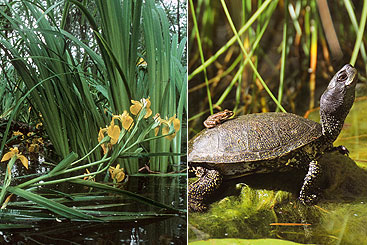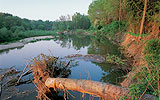Biodiversity and water

Biodiversity and water
Countries are working together to implement legislation that seeks to increase the resilience of biodiversity in aquatic ecosystems by balancing sustainable water use with the long-term protection of available resources.

The Danube River Basin, including its tributaries, is home to around 2,000 plant and 5,000 animal species, including numerous endangered or nearly extinct species.
2010 is the international year of biodiversity and also important forwater. Although rivers and lakesmake up only 1% of the globe‘s land area, freshwater ecosystems host a disproportionally rich diversity of species. Some 40% of Natura 2000 sites contain freshwater habitats, and many more terrestrial habitats are waterdependent. Likewise, 70% of protected habitats and species are aquatic or water-dependent.
But not all of them are in good condition. An EU-wide assessment has recently shown that for rivers and lakes, only 15% of the habitats are in favourable conservation status and 13% of their species. For wetlands these numbers are even lower with 8% of the habitats and 14% of the species in favourable condition. And for about one fifth of the assessments the status remains unknown.
Aquatic biodiversity is under increasing pressure: nutrients flowing off the land lead to the eutrophication of our rivers and streams. Poor land use and land management increases the degradation of habitats and loss of species. Rivers are straightened, natural floodplains detached and habitats fragmented through dams and weirs. In the Danube, for example, the sturgeon is particularly affected by existing dams and new infrastructure projects but also by poaching and hybridisation with exotic species. Invasive alien species are negatively impacting the natural fauna and flora in many rivers and lakes. While 90% of the 11,000 alien species in Europe are terrestrial, 28% of the most harmful species are found in freshwater.

The floodplains and wetlands of the Danube basin are uniquely valuable ecosystems in global terms, although few areas are still in their natural or near-natural state. Over the last two centuries in particular, most of the larger floodplain areas have disappeared.
Existing legislation. EU water policy seeks to increase the resilience of biodiversity and ecosystems by balancing sustainable water use with the long-term protection of available resources. TheWater Framework Directive (WFD) implementation is closely linked to nature protection and biodiversity aspects. “Improving the status of water bodies means better habitats for aquatic organisms and other water-dependent species,” says Heide Jekel from the water department of Germany’s Federal Environment Ministry.
The WFD establishes a framework for the protection of all surface waters and groundwater with the aim of reaching ‘good status’ in all waters by 2015. The Birds and the Habitats Directives together form the backbone of the EU’s biodiversity policy as they protect Europe’s most valuable species and habitats. Both the nature directives and the WFD aim to ensure healthy aquatic ecosystems while at the same time find a balance between water/nature protection and the sustainable use of nature’s natural resources. Indeed there are many synergies as the implementation of measures under the WFD will generally benefit the objectives of the nature directives.
Integration of biodiversity in sector policies. A recent workshop called ‘Biodiversity and Water – Links between the Water Framework Directive and EU Nature legislation’ held in Brussels on 17-18 June 2010 has taken a closer look at possible synergies but also difficulties in combining necessary measures under the WFD and nature legislation. More than 120 participants from EU Member States, NGOs and stakeholders convened to discuss how to improve the implementation of these directives and how to develop integrated river basin management plans which cover both the protection of water resources, aquatic species and habitats as well as the sustainable use of water. There are many encouraging examples showing that it is possible to achieve win-win situations, where water uses such as navigation or flood protection measures can be successfully integrated with achieving good ecological status of waters and favourable conservation status of protected species and habitats.
For more information on the results of the workshop, including background information on best practice case studies, please visit:
http://circa.europa.eu/Public/irc/env/wfd/library?l=/
framework_directive/implementation_conventio/
biodiversity_legislation&vm=detailed&sb=Title






